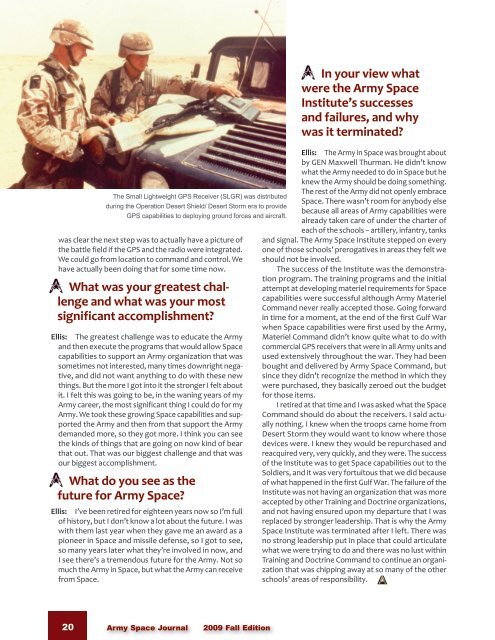Volume 8, Number 3 - Space and Missile Defense Command - U.S. ...
Volume 8, Number 3 - Space and Missile Defense Command - U.S. ...
Volume 8, Number 3 - Space and Missile Defense Command - U.S. ...
Create successful ePaper yourself
Turn your PDF publications into a flip-book with our unique Google optimized e-Paper software.
In your view what<br />
were the Army <strong>Space</strong><br />
Institute’s successes<br />
<strong>and</strong> failures, <strong>and</strong> why<br />
was it terminated?<br />
Ellis: The Army in <strong>Space</strong> was brought about<br />
by GEN Maxwell Thurman. He didn’t know<br />
what the Army needed to do in <strong>Space</strong> but he<br />
knew the Army should be doing something.<br />
The rest of the Army did not openly embrace<br />
The Small Lightweight GPS Receiver (SLGR) was distributed<br />
<strong>Space</strong>. There wasn’t room for anybody else<br />
during the Operation Desert Shield/ Desert Storm era to provide<br />
because all areas of Army capabilities were<br />
GPS capabilities to deploying ground forces <strong>and</strong> aircraft.<br />
already taken care of under the charter of<br />
each of the schools – artillery, infantry, tanks<br />
was clear the next step was to actually have a picture of<br />
the battle field if the GPS <strong>and</strong> the radio were integrated.<br />
We could go from location to comm<strong>and</strong> <strong>and</strong> control. We<br />
have actually been doing that for some time now.<br />
What was your greatest challenge<br />
<strong>and</strong> signal. The Army <strong>Space</strong> Institute stepped on every<br />
one of those schools’ prerogatives in areas they felt we<br />
should not be involved.<br />
The success of the Institute was the demonstration<br />
program. The training programs <strong>and</strong> the initial<br />
attempt at developing materiel requirements for <strong>Space</strong><br />
<strong>and</strong> what was your most<br />
capabilities were successful although Army Materiel<br />
Comm<strong>and</strong> never really accepted those. Going forward<br />
significant accomplishment?<br />
in time for a moment, at the end of the first Gulf War<br />
when <strong>Space</strong> capabilities were first used by the Army,<br />
Ellis: The greatest challenge was to educate the Army Materiel Comm<strong>and</strong> didn’t know quite what to do with<br />
<strong>and</strong> then execute the programs that would allow <strong>Space</strong><br />
capabilities to support an Army organization that was<br />
sometimes not interested, many times downright negative,<br />
<strong>and</strong> did not want anything to do with these new<br />
things. But the more I got into it the stronger I felt about<br />
it. I felt this was going to be, in the waning years of my<br />
Army career, the most significant thing I could do for my<br />
Army. We took these growing <strong>Space</strong> capabilities <strong>and</strong> supported<br />
the Army <strong>and</strong> then from that support the Army<br />
dem<strong>and</strong>ed more, so they got more. I think you can see<br />
the kinds of things that are going on now kind of bear<br />
that out. That was our biggest challenge <strong>and</strong> that was<br />
our biggest accomplishment.<br />
What do you see as the<br />
commercial GPS receivers that were in all Army units <strong>and</strong><br />
used extensively throughout the war. They had been<br />
bought <strong>and</strong> delivered by Army <strong>Space</strong> Comm<strong>and</strong>, but<br />
since they didn’t recognize the method in which they<br />
were purchased, they basically zeroed out the budget<br />
for those items.<br />
I retired at that time <strong>and</strong> I was asked what the <strong>Space</strong><br />
Comm<strong>and</strong> should do about the receivers. I said actually<br />
nothing. I knew when the troops came home from<br />
Desert Storm they would want to know where those<br />
devices were. I knew they would be repurchased <strong>and</strong><br />
reacquired very, very quickly, <strong>and</strong> they were. The success<br />
of the Institute was to get <strong>Space</strong> capabilities out to the<br />
Soldiers, <strong>and</strong> it was very fortuitous that we did because<br />
of what happened in the first Gulf War. The failure of the<br />
Institute was not having an organization that was more<br />
future for Army <strong>Space</strong>?<br />
accepted by other Training <strong>and</strong> Doctrine organizations,<br />
Ellis: I’ve been retired for eighteen years now so I’m full <strong>and</strong> not having ensured upon my departure that I was<br />
of history, but I don’t know a lot about the future. I was<br />
with them last year when they gave me an award as a<br />
pioneer in <strong>Space</strong> <strong>and</strong> missile defense, so I got to see,<br />
so many years later what they’re involved in now, <strong>and</strong><br />
I see there’s a tremendous future for the Army. Not so<br />
much the Army in <strong>Space</strong>, but what the Army can receive<br />
from <strong>Space</strong>.<br />
replaced by stronger leadership. That is why the Army<br />
<strong>Space</strong> Institute was terminated after I left. There was<br />
no strong leadership put in place that could articulate<br />
what we were trying to do <strong>and</strong> there was no lust within<br />
Training <strong>and</strong> Doctrine Comm<strong>and</strong> to continue an organization<br />
that was chipping away at so many of the other<br />
schools’ areas of responsibility.<br />
20<br />
Army <strong>Space</strong> Journal<br />
2009 Fall Edition
















